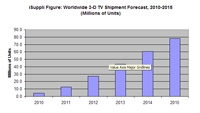Consumers to flock to 3-D TVs when key challenges overcome, says iSuppli

Multiple challenges must be surmounted before consumer sales of 3-D TVs will take off, according to market research firm iSuppli.
While some consumers are buying 3-D TVs, obstacles such as standardization, content availability and interoperability must be resolved. The research company, which recently released a report entitled "3-D TV—Can it Drive the Next Round of Replacements," forecasts some 4.2 million 3-D TVs will be sold this year, largely due to interest from early adopters.
Worldwide, 3-D TV shipments will triple to 12.9 million units in 2011 and more than double to 27.4 million units in 2012, according to the iSuppli estimate. In 2015, 3-D TV shipments will reach 78.1 million units, a compound annual growth rate of 80.2 percent from 2010, the research firm said.
Most 3-D TV sales in 2010 will occur in the mature television regions of the United States, Japan, and Western Europe, where sizable markets exist for upgrading or replacing older, non-3-D sets, said iSuppli. Television viewers in South Korea and Australia also will adopt 3-D TVs.
Despite the strong showing, 3-D TVs account for only a small portion of the overall television market. The forecasted surge in growth will not occur until concerns over standardization, content availability and interoperability of 3-D glasses are resolved, said iSuppli principal analyst Riddhi Patel.
The professional video industry's #1 source for news, trends and product and tech information. Sign up below.
